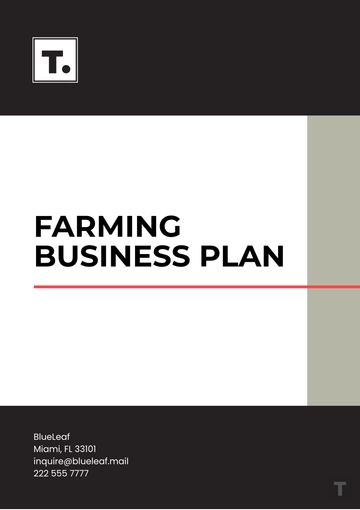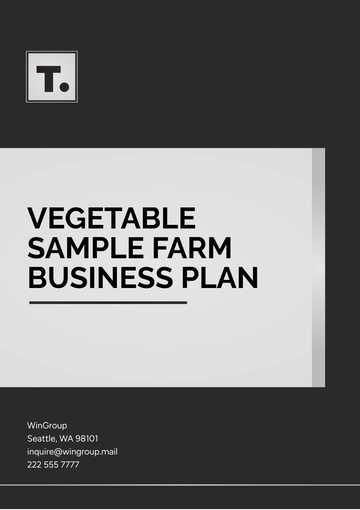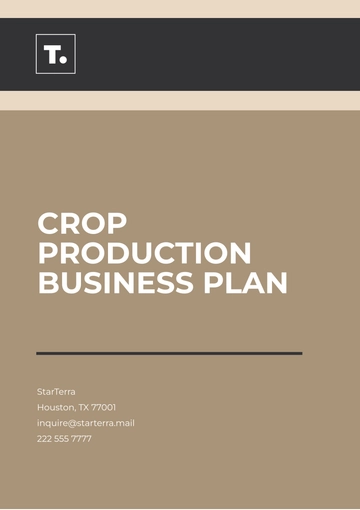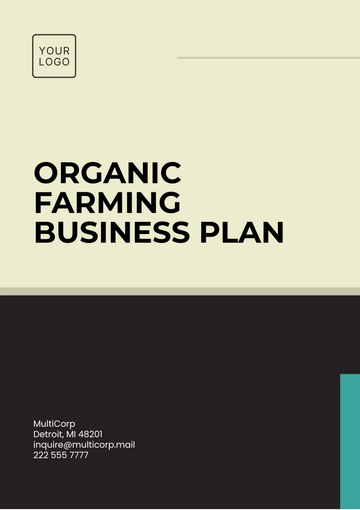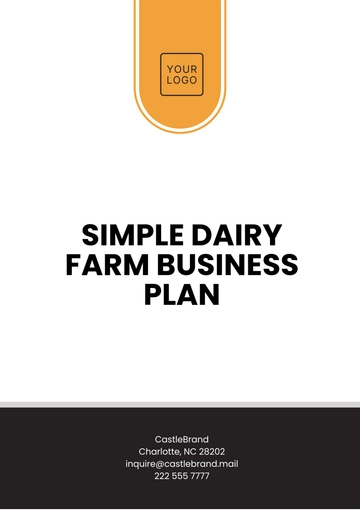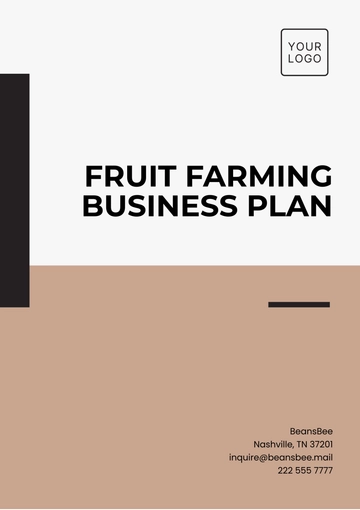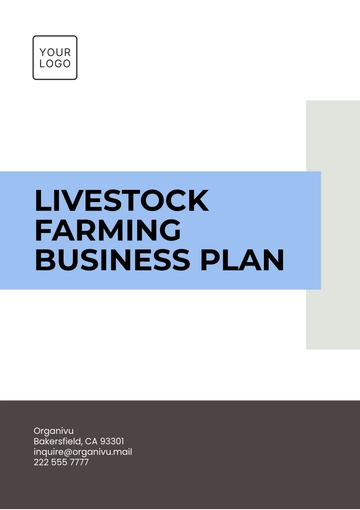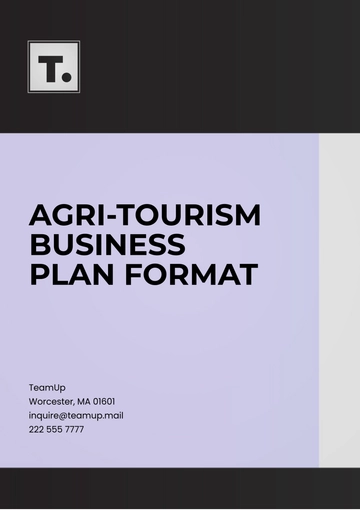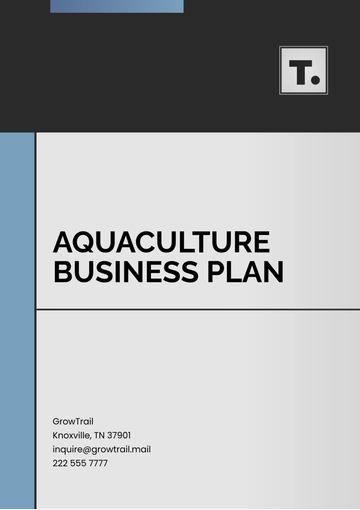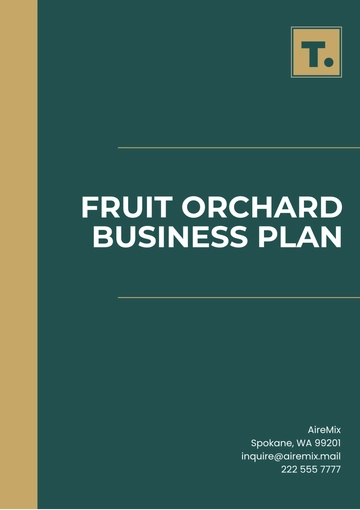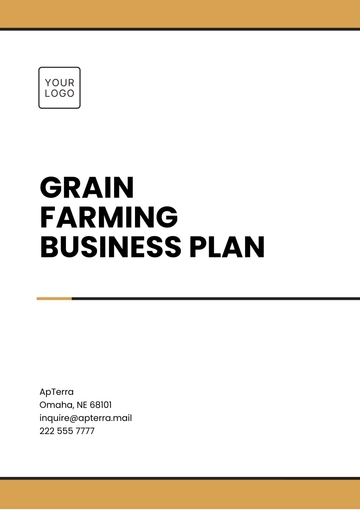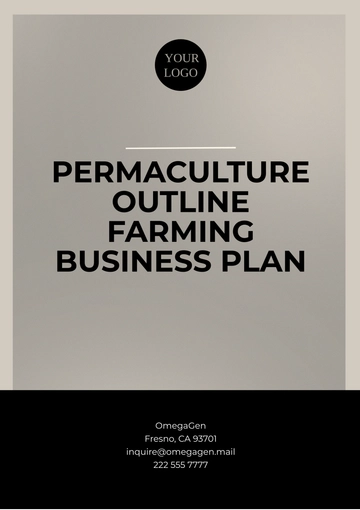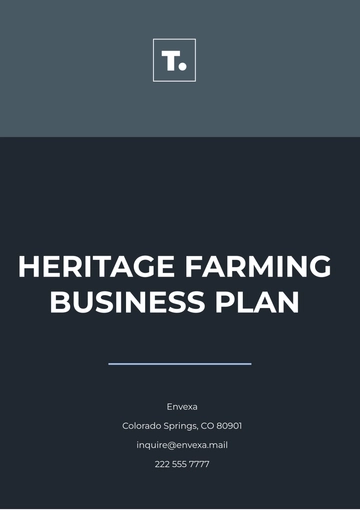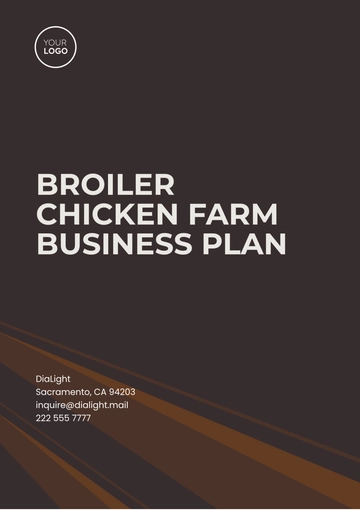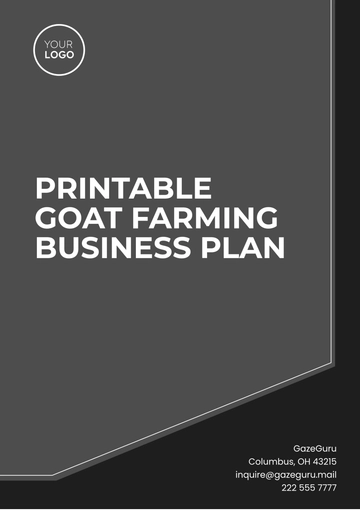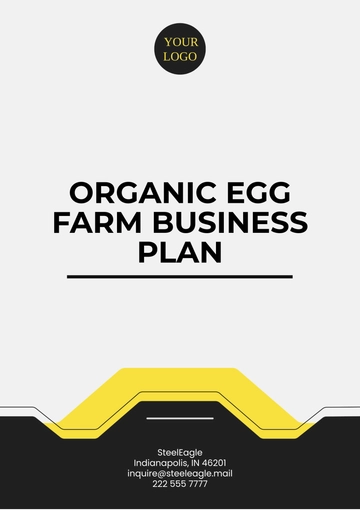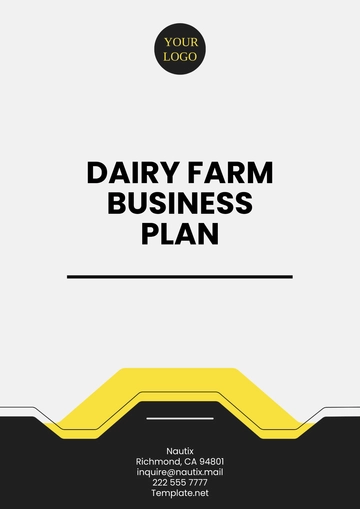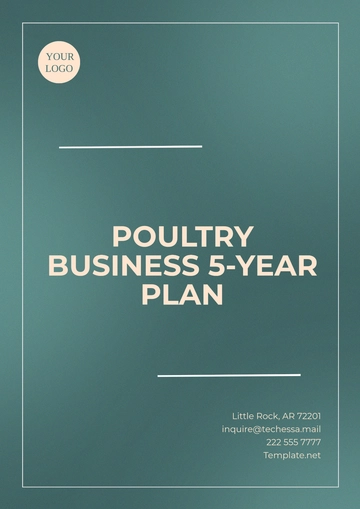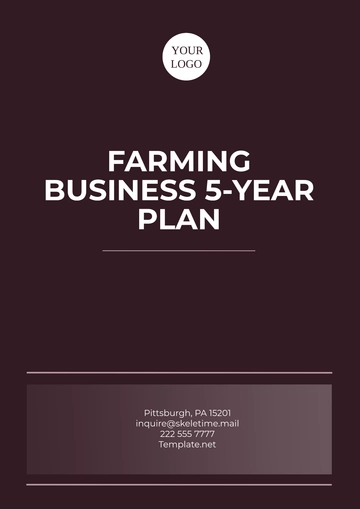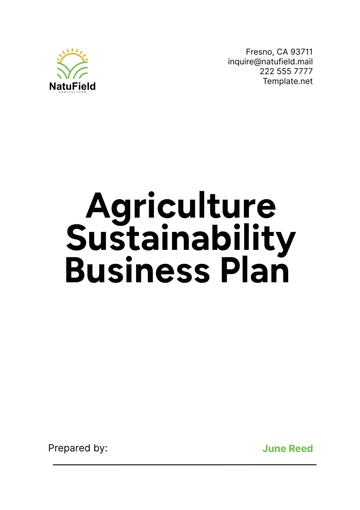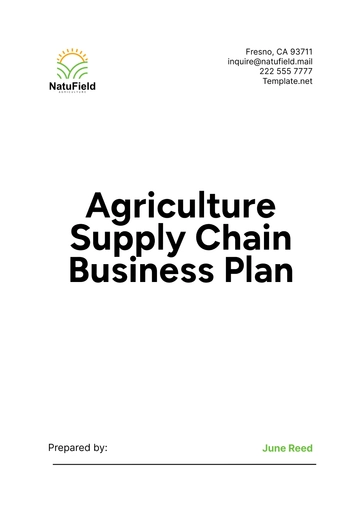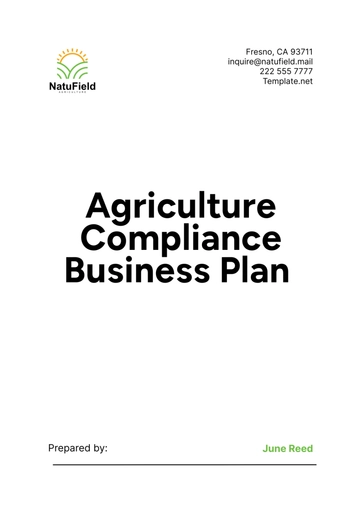Free Agriculture Business Plan
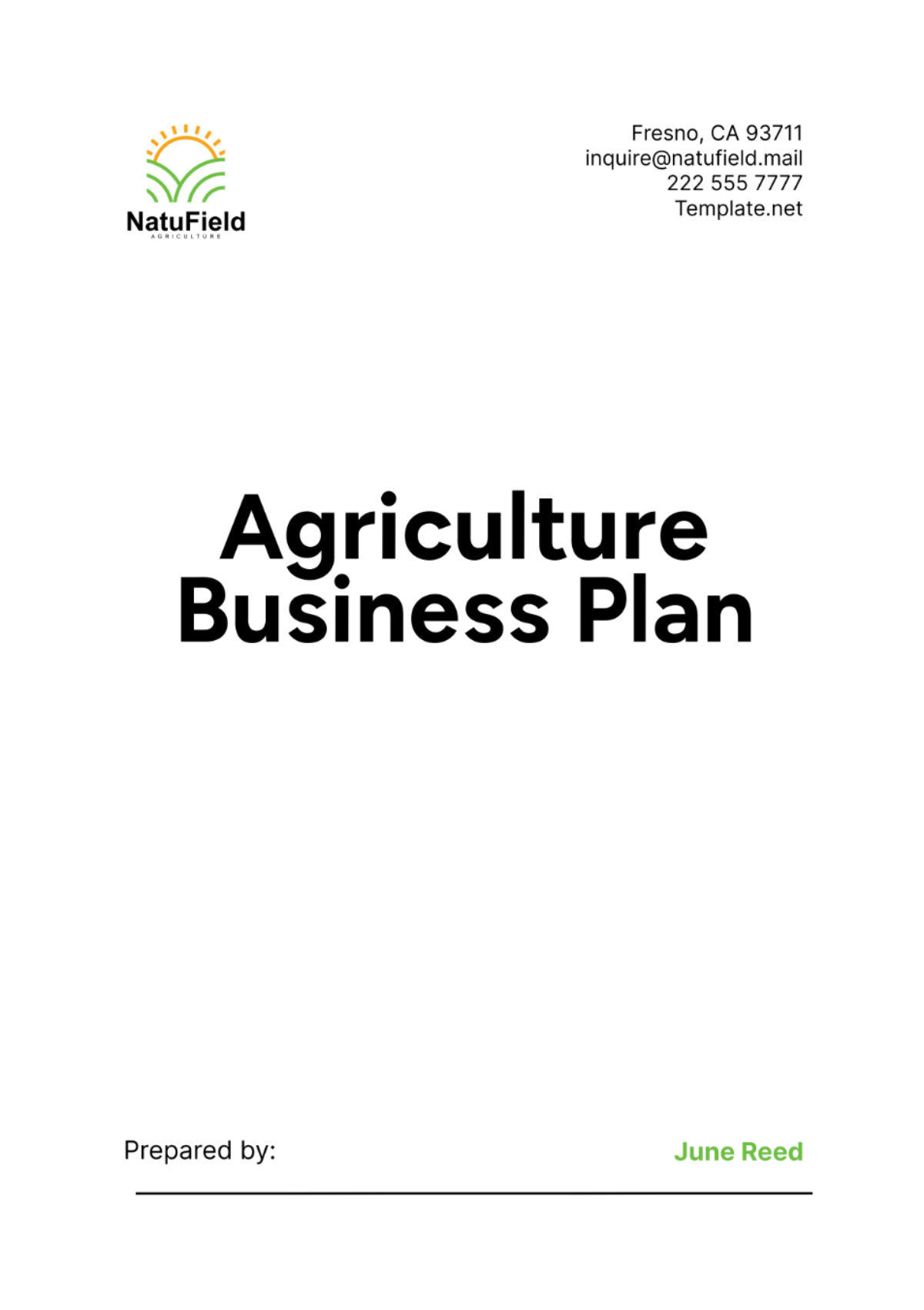
I. Executive Summary
A. Overview of the Business
[Your Company Name] is positioned as a premium organic vegetable producer located in the fertile [Location]. With a dedication to sustainable farming practices, we aim to meet the rising demand for locally grown, pesticide-free produce. Our commitment to quality and community engagement drives our mission to deliver fresh, nutritious vegetables that enhance consumer health and support environmental stewardship.
B. Mission Statement
At [Your Company Name], our mission is to cultivate and distribute high-quality organic vegetables while promoting sustainable agriculture practices. We strive to enrich our community by providing nutritious, flavorful produce that embodies our commitment to health, sustainability, and environmental responsibility.
C. Business Objectives
Our primary objectives are to establish [Your Company Name] as a recognized brand within the organic farming sector, achieve profitability within the first three years, and expand production to meet increasing market demand. By year five, we aim to secure a prominent market share in the local organic vegetable market through consistent quality and customer satisfaction.
D. Key Success Factors
Key factors contributing to our success include our focus on heirloom varieties renowned for taste and nutrition, strategic alliances with local distributors and restaurants, and continuous innovation in sustainable farming techniques. By prioritizing consumer health and environmental sustainability, we aim to build long-term relationships with our customers and stakeholders.
II. Business Description
A. Farming Operation Overview
[Your Company Name] specializes in the cultivation of a diverse range of organic vegetables, leveraging sustainable practices such as crop rotation and integrated pest management. Our farm spans 50 acres of prime agricultural land, equipped with state-of-the-art irrigation systems and greenhouses for year-round production. We prioritize soil health and biodiversity to ensure sustainable yields and premium quality produce.
B. Legal Structure and Ownership
As an LLC, [Your Company Name] is owned and operated by [Owner Name], who brings [0] years of experience in organic farming and agricultural management. We adhere to all local agricultural regulations and maintain organic certification to guarantee the integrity of our products and practices.
C. Location and Facilities
Located in [Location], our farm benefits from rich soil and a favorable climate ideal for organic farming. Our facilities include temperature-controlled storage barns and packing areas to preserve freshness and quality during distribution. Proximity to urban centers allows for efficient delivery to local markets, ensuring timely access to consumers seeking premium organic vegetables.
D. History and Background
Established in [Year], [Your Company Name] began as a family-owned venture driven by a passion for sustainable agriculture. Over the years, we have expanded our operations while maintaining a commitment to environmental stewardship and community engagement. Our journey is characterized by continuous improvement in farming techniques and customer-focused innovation.
III. Market Analysis
A. Industry Overview
The organic vegetable market is experiencing significant growth driven by increasing consumer awareness of health and environmental sustainability. Consumers are increasingly choosing organic produce for its nutritional benefits and reduced environmental impact. This trend presents a favorable opportunity for [Your Company Name] to establish a strong presence in the local market as a trusted supplier of premium organic vegetables.
B. Target Market Segmentation
Our target market includes health-conscious individuals, families, local restaurants, and specialty grocery stores seeking fresh, locally sourced organic vegetables. We segment our market based on demographic factors such as age, income level, and lifestyle preferences, ensuring tailored marketing strategies to meet diverse consumer needs.
C. Customer Needs and Preferences
Consumers prioritize freshness, flavor, and nutritional value when purchasing organic vegetables. They value transparency in farming practices and seek assurances of organic certification to ensure product authenticity. [Your Company Name] addresses these preferences by delivering farm-fresh produce directly to consumers and retail partners, emphasizing quality and sustainability in every harvest.
D. Competitive Analysis
Direct Competitors
Local organic farms like [Competitor A] and [Competitor B] offer similar products with established customer bases. Differentiating factors include our focus on heirloom varieties, direct-from-farm freshness, and commitment to sustainable farming practices.
Indirect Competitors
Conventional farms and imported organic produce from larger distributors pose indirect competition. However, [Your Company Name] distinguishes itself through local sourcing, superior quality control, and personalized customer service strategies.
IV. Products and Services
A. Product Lines and Offerings
[Your Company Name] offers a diverse selection of organic vegetables, including heirloom tomatoes, colorful bell peppers, leafy greens, and specialty herbs. Our products are renowned for their exceptional flavor profiles and nutritional benefits, appealing to discerning consumers seeking premium organic options for culinary and health-conscious purposes.
B. Unique Selling Propositions (USPs)
Heirloom Variety Emphasis
We specialize in heirloom vegetables celebrated for their unique flavors and historical significance, distinguishing us from competitors focused on conventional varieties.
Direct-from-Farm Freshness
Our produce is harvested daily and delivered directly to local markets and restaurants, ensuring unparalleled freshness and nutritional integrity.
Sustainability Commitment
[Your Company Name] is committed to sustainable farming practices, including organic certification, soil health management, and water conservation initiatives, aligning with consumer values and environmental stewardship.
C. Production Processes and Techniques
At [Your Company Name], we prioritize sustainable agriculture through organic farming techniques such as crop rotation, composting, and natural pest management. These practices promote soil fertility, minimize environmental impact, and enhance the nutritional content of our produce. By integrating cutting-edge agricultural technologies and proven methods, we optimize yields while preserving the natural ecosystem for future generations.
D. Quality Control Measures
Each stage of our production process is meticulously monitored to uphold the highest standards of quality and safety. From seed selection to harvest and post-harvest handling, we implement stringent quality control protocols to ensure compliance with organic certification requirements and customer expectations. Our commitment to quality assurance extends to packaging and distribution, guaranteeing that every [Your Company Name] product meets or exceeds industry standards for freshness and purity.
V. Marketing and Sales Strategy
A. Marketing Goals and Objectives
[Your Company Name] aims to build brand recognition and market penetration within the local organic vegetable sector. Our primary objectives include increasing consumer awareness of our brand and product offerings, establishing partnerships with local distributors and restaurants, and achieving a significant market share within the first two years of operation. Through targeted marketing campaigns and community engagement initiatives, we seek to educate consumers about the benefits of organic farming and differentiate [Your Company Name] as a trusted source for premium quality vegetables.
B. Branding and Positioning
[Your Company Name] positions itself as the premier choice for discerning consumers seeking fresh, flavorful organic vegetables. Our brand identity emphasizes our commitment to sustainable farming practices, product quality, and community support. By showcasing our dedication to environmental stewardship and nutritional excellence, we aim to resonate with health-conscious individuals, chefs, and retail partners looking for reliable, locally sourced organic produce.
C. Promotion and Advertising Strategies
We employ a multi-channel approach to promote [Your Company Name], including digital marketing, social media engagement, local events, and participation in farmers' markets. Our online presence includes a user-friendly website showcasing our product offerings, farming practices, and customer testimonials. Social media platforms such as Instagram and Facebook are utilized to share farm updates, seasonal recipes, and engaging content that highlights our farm-to-table journey. Additionally, partnerships with local influencers and collaborations with culinary professionals amplify our brand visibility and credibility among target audiences.
D. Sales Channels and Distribution
[Your Company Name] utilizes both direct-to-consumer and wholesale distribution channels to maximize market reach and accessibility. We sell our products through on-farm sales, farmers' markets, and a subscription-based Community Supported Agriculture (CSA) program, providing consumers with convenient access to fresh produce on a regular basis. In addition, we partner with local grocery stores, restaurants, and specialty food retailers to distribute our vegetables, ensuring broader market coverage and meeting diverse customer preferences.
VI. Organization and Management
A. Organizational Structure
[Your Company Name] operates with a streamlined organizational structure designed to facilitate efficient communication and decision-making. Our team comprises dedicated professionals overseeing key functions including production, sales and marketing, administrative operations, and quality control. By fostering a collaborative work environment and leveraging each team member's expertise, we enhance operational effectiveness and responsiveness to market dynamics.
B. Key Management Team
[Owner Name], Founder & CEO
As the visionary leader, [Owner Name] provides strategic direction and oversees overall business operations, leveraging [0] years of experience in organic farming and agricultural management.
[Key Personnel Names]
Our management team includes seasoned professionals with specialized knowledge in organic agriculture, marketing, and supply chain management. Together, we bring a collective commitment to excellence, innovation, and sustainable growth to [Your Company Name].
C. Staffing Plan and Responsibilities
[Your Company Name] employs skilled farmhands responsible for day-to-day agricultural activities such as planting, harvesting, and crop maintenance. Administrative staff manage customer relations, logistics, financial transactions, and regulatory compliance, ensuring seamless operations and exceptional service delivery. Our staffing plan emphasizes continuous training and development to foster a culture of excellence, teamwork, and professional growth among our dedicated workforce.
D. Advisory Board or Consultants
We collaborate with agricultural experts, sustainability consultants, and legal advisors to enhance operational efficiency, navigate regulatory requirements, and capitalize on emerging market opportunities. Their invaluable guidance and strategic insights enable [Your Company Name] to implement best practices in organic farming, mitigate operational risks, and achieve sustainable business growth.
VII. Funding Request and Financial Projections
A. Funding Requirements
[Your Company Name] seeks $[0] in initial funding to support land acquisition, infrastructure development, operational expenses, and marketing initiatives during the startup phase. The funding will enable us to establish a robust foundation for growth and profitability within the competitive organic vegetable market.
B. Use of Funds
Allocation of funds includes [0]% for land purchase and development, [0]% for infrastructure investments including irrigation systems and greenhouses, [0]% for initial working capital to cover operational costs, and [0]% for strategic marketing campaigns to build brand awareness and market presence.
C. Financial Projections
Income Statement
Projected revenue growth based on market demand, production capacity, and pricing strategies. We anticipate steady revenue increases as we expand our customer base and enhance product offerings.
Cash Flow Statement
Forecasting cash inflows and outflows to ensure sufficient liquidity and financial stability throughout the startup and operational phases.
Balance Sheet
Illustrating assets, liabilities, and equity position over the next five years, reflecting the anticipated growth and profitability of [Your Company Name].
D. Break-even Analysis
[Your Company Name] aims to achieve break-even within [Timeline], marking the point at which monthly revenue covers operating expenses. This milestone indicates our transition to profitability and financial sustainability as we continue to scale operations and optimize efficiencies.
VIII. Risk Analysis and Mitigation
A. Risk Factors
Potential risks include adverse weather conditions affecting crop yields, pest outbreaks impacting production, market volatility affecting pricing and demand, and regulatory changes influencing organic certification requirements. These factors pose operational challenges that could affect [Your Company Name]'s profitability and market competitiveness.
B. Risk Management Strategies
We mitigate risks through proactive measures such as crop diversification, insurance coverage for crop losses, and contingency plans to manage unexpected challenges. By maintaining robust supplier relationships and diversifying sales channels, we enhance resilience against market fluctuations and supply chain disruptions. Regular monitoring of market trends and regulatory updates enables us to adapt swiftly and implement strategic adjustments to mitigate potential risks effectively.
C. Contingency Plans
[Your Company Name] maintains reserve funds for emergencies and unforeseen circumstances, ensuring operational continuity and financial stability during challenging periods. Our contingency plans include alternative sourcing options, flexible production scheduling, and adaptive marketing strategies to maintain customer satisfaction and market presence in dynamic business environments.
D. Legal and Regulatory Considerations
We adhere to stringent compliance with local, state, and federal regulations governing organic farming practices, food safety standards, labor laws, and environmental stewardship. [Your Company Name] prioritizes transparency and accountability in all business operations, ensuring full compliance with regulatory requirements to safeguard product integrity and consumer trust.
IX. Implementation Plan
A. Timeline and Milestones
Year 1: Secure land acquisition, develop infrastructure including greenhouses and irrigation systems, commence initial planting and crop trials.
Year 2: Expand production capacity, launch marketing campaigns to build brand awareness, establish partnerships with local distributors and restaurants.
Year 3: Achieve full-scale production, enhance operational efficiencies, and achieve profitability targets.
B. Operational Plan
Production Schedule
Implement seasonal planting and harvesting schedules optimized for crop rotation and soil health management. Integrate technology-driven solutions for precision farming and yield optimization.
Supply Chain Management
Streamline logistics for efficient distribution to local markets, restaurants, and retail partners. Implement inventory management systems to ensure timely delivery and inventory control.
C. Monitoring and Evaluation
[Your Company Name] conducts regular performance evaluations using key performance indicators (KPIs) such as revenue growth, customer satisfaction ratings, and operational efficiency metrics. Feedback from consumers, distributors, and stakeholders informs continuous improvement initiatives and strategic decision-making to align with business objectives and market dynamics.
D. Scalability and Growth Strategy
Our growth strategy focuses on expanding market reach, diversifying product offerings, and exploring vertical integration opportunities within the organic food sector. We leverage strategic partnerships, technology investments, and consumer insights to capitalize on emerging market trends and sustain long-term business growth while maintaining our commitment to sustainable practices and customer satisfaction.
- 100% Customizable, free editor
- Access 1 Million+ Templates, photo’s & graphics
- Download or share as a template
- Click and replace photos, graphics, text, backgrounds
- Resize, crop, AI write & more
- Access advanced editor
Improve your agricultural ventures with the Agriculture Business Plan Template from Template.net. This editable and customizable template includes a user-friendly AI Editor Tool, making it easy to tailor your business strategy to perfection. Whether you're starting a farm or expanding operations, harness the power of this template to craft a comprehensive and professional business plan effortlessly.
You may also like
- One Page Business Plan
- Coffee Shop Business Plan
- Restaurant Business Plan
- Food Business Plan
- Real Estate Business Plan
- Executive Summary Business Plan
- Cover Page Business Plan
- Nonprofit Business Plan
- Daycare Business Plan
- Construction Business Plan
- Startup Business Plan
- Medical Business Plan
- Bakery Business Plan
- Service Plan
- Hotel Business Plan
- Catering Business Plan
- School Business Plan
- Healthcare Business Plan
- Transportation Plan
- Sports Plan
- Car Wash Business Plan
- Salon Business Plan
- Clothing Business Plan
- Farming Business Plan
- Boutique Plan
